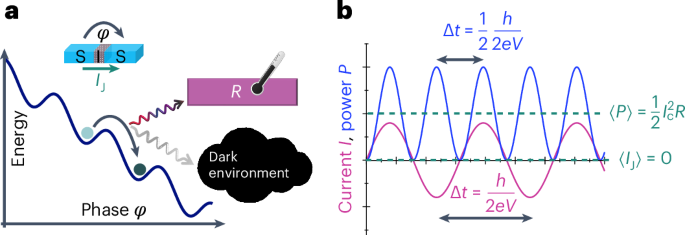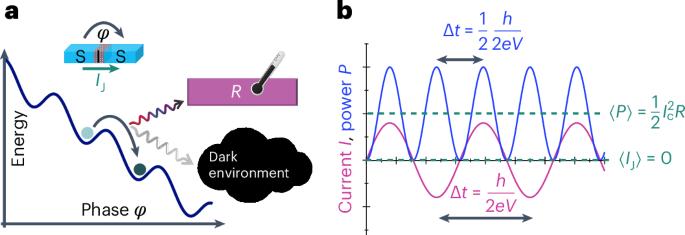Bolometric detection of Josephson radiation
IF 38.1
1区 材料科学
Q1 MATERIALS SCIENCE, MULTIDISCIPLINARY
引用次数: 0
Abstract
One of the most promising approaches towards large-scale quantum computation uses devices based on many Josephson junctions. Yet, even today, open questions regarding the single junction remain unsolved, such as the detailed understanding of the quantum phase transitions, the coupling of the Josephson junction to the environment or how to improve the coherence of a superconducting qubit. Here we design and build an engineered on-chip reservoir connected to a Josephson junction that acts as an efficient bolometer for detecting the Josephson radiation under non-equilibrium, that is, biased conditions. The bolometer converts the a.c. Josephson current at microwave frequencies up to about 100 GHz into a temperature rise measured by d.c. thermometry. A circuit model based on realistic parameter values captures both the current–voltage characteristics and the measured power quantitatively. The present experiment demonstrates an efficient, wide-band, thermal detection scheme of microwave photons and provides a sensitive detector of Josephson dynamics beyond the standard conductance measurements. An on-chip nano-bolometer integrated with a Josephson junction quantitatively measures the Josephson radiation up to about 100 GHz frequency. This wide-band, thermal detection scheme of microwave photons provides a sensitive detector of Josephson dynamics beyond the standard conductance measurements.


约瑟夫森辐射的测光探测
实现大规模量子计算的最有前途的方法之一是使用基于许多约瑟夫森结的设备。然而,时至今日,有关单结的开放性问题仍未得到解决,例如对量子相变的详细了解、约瑟夫森结与环境的耦合或如何提高超导量子比特的相干性。在这里,我们设计并建造了一个与约瑟夫森结相连的工程片上储能器,它可以作为一个高效的辐射计,在非平衡即偏置条件下探测约瑟夫森辐射。该测温仪将高达约 100 千兆赫微波频率下的交流约瑟夫森电流转换为直流测温仪测量的温升。基于实际参数值的电路模型可以定量捕捉电流-电压特性和测量功率。本实验展示了一种高效、宽带、微波光子热检测方案,并提供了一种超越标准电导测量的约瑟夫森动态灵敏检测器。
本文章由计算机程序翻译,如有差异,请以英文原文为准。
求助全文
约1分钟内获得全文
求助全文
来源期刊

Nature nanotechnology
工程技术-材料科学:综合
CiteScore
59.70
自引率
0.80%
发文量
196
审稿时长
4-8 weeks
期刊介绍:
Nature Nanotechnology is a prestigious journal that publishes high-quality papers in various areas of nanoscience and nanotechnology. The journal focuses on the design, characterization, and production of structures, devices, and systems that manipulate and control materials at atomic, molecular, and macromolecular scales. It encompasses both bottom-up and top-down approaches, as well as their combinations.
Furthermore, Nature Nanotechnology fosters the exchange of ideas among researchers from diverse disciplines such as chemistry, physics, material science, biomedical research, engineering, and more. It promotes collaboration at the forefront of this multidisciplinary field. The journal covers a wide range of topics, from fundamental research in physics, chemistry, and biology, including computational work and simulations, to the development of innovative devices and technologies for various industrial sectors such as information technology, medicine, manufacturing, high-performance materials, energy, and environmental technologies. It includes coverage of organic, inorganic, and hybrid materials.
 求助内容:
求助内容: 应助结果提醒方式:
应助结果提醒方式:


